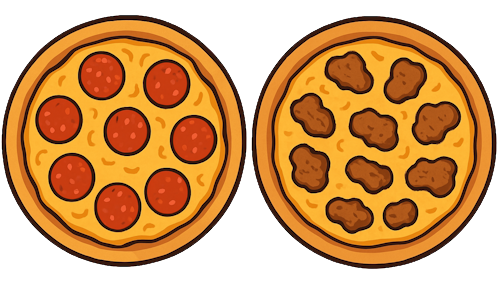2-Pizza Team Rule
Teams should be small enough to be fed with two pizzas.
"We try to create teams that are no larger than can be fed by two pizzas." 1

The "2-Pizza Team Rule" was popularized by Jeff Bezos to illustrate an essential constraint in team design: if a team cannot be fed with two pizzas, it is too large. While it began as a witty metaphor, it has become a widely embraced heuristic in Agile organizations. The rule emphasizes maintaining small, autonomous teams to reduce communication overhead, enhance accountability, and preserve nimbleness. In the context of Agile, it aligns with core principles such as self-organization, rapid feedback, and continuous delivery.
Impact on Agile Teams
Small teams, typically 5 to 9 members, can coordinate more easily, make decisions faster, and adapt more fluidly to change. Larger teams often suffer from coordination drag, diluted ownership, and slower feedback cycles. When this rule is followed, Agile teams experience:
- Sharper focus and clearer roles.
- Faster alignment and decision-making.
- Reduced cross-talk and context switching.
- Easier Retrospectives and continuous improvement loops
However, misapplying the rule can lead to fragmentation, knowledge silos, or under-resourced teams that struggle with delivery scope.
Scenario
An enterprise launches a new digital product initiative with a team of 15 people, spanning frontend, backend, QA, DevOps, and UX. Despite their talent:
- Meetings are chaotic.
- Stories are blocked waiting for others.
- Sprint Goals are rarely met.
- Retrospectives surface recurring issues about unclear ownership and too many "moving parts".
Without realizing it, the team's size has become a liability. Communication overhead increases exponentially with team size, and their cognitive load rises. What began as an effort to "move faster with more people" has actually led to friction, missed dependencies, and fatigue
Ways to Mitigate
To course-correct and embody the 2-Pizza Team Rule without sacrificing capability:
- Split the team by domain or service boundary, ensuring each has a distinct backlog and cross-functional skillset.
- Introduce a shared goal or portfolio layer, such as a Scrum of Scrums or a Product Owner sync, to maintain coherence across teams.
- Reinforce autonomy with clear boundaries (APIs, interfaces, service ownership) to reduce handoffs.
- Invest in shared knowledge and standards, such as coding guidelines or Definition of Done, to prevent divergence.
Rather than scaling up a single team, scale through consistent patterns and communication scaffolds.
Conclusion:
The 2-Pizza Team Rule offers a practical reminder that smaller, well-structured teams are more effective in Agile environments. Rather than aiming for large groups to handle more work, Agile organizations benefit from keeping teams small enough to move quickly, communicate clearly, and maintain a strong sense of ownership. When applied thoughtfully, this principle helps teams avoid the common pitfalls of coordination overload and diluted accountability, leading to faster feedback, better focus, and stronger results.
Key Takeaways
- The 2-Pizza Team Rule recommends keeping teams small enough to be fed by two pizzas, typically no more than 8 or 9 people.
- It reduces coordination overhead, accelerates feedback, and empowers ownership.
- Overly large teams slow down delivery and introduce confusion.
- Scaling should occur by forming multiple small, well-bounded teams - not by inflating one.
Summary
The 2-Pizza Team Rulehighlights the value of small, cross-functional teams in Agile environments. Teams that are too large tend to move slowly and lose alignment. By organizing around focused, nimble groups with clear ownership, organizations can maintain agility at scale and respond more effectively to change.